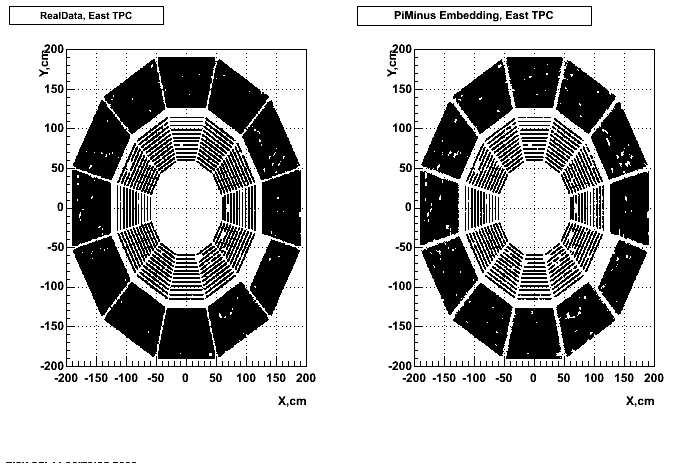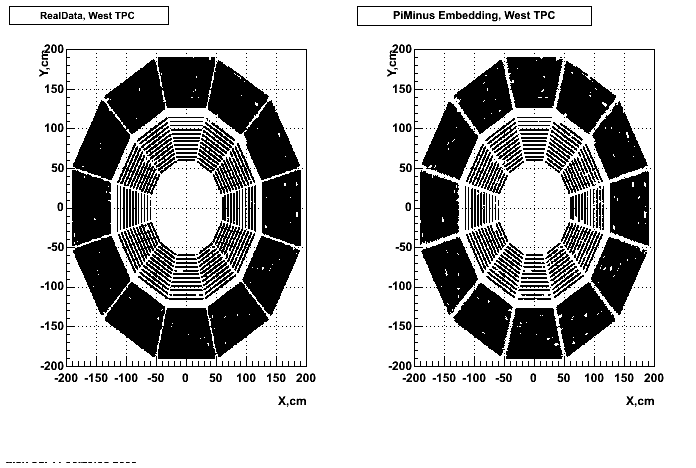In my azimuthal sDCA studies, I observed static and dynamic azimuthal asymmetries in the CuCu200 data. One suggested possible way to avoid this in upcoming heavy ion runs is to see if there are any online scalers which could be used to give feedback to C-AD as to whether backgrounds at STAR are acceptable in terms of TPC ionization distortions. Towards this end, I have begun a study of whether the BBC scalers might be useful in this regard.
It is important to understand some things about the BBC geometry. Ideally, the large outer tiles are closer to the TPC and more likely represent information relevant to what is happening in the TPC. We would most likely want to implement scalers for these in an upcoming heavy ion run. Unfortunately, in the past we have only taken scaler data for the smaller inner tiles, which are at much smaller radii than the TPC. I show below a schematic I have made of the BBC geometry and PMT layout with respect to a view from the west side of the IR (looking east).

I have arranged the following plots similarly to my azimuthal sDCA studies. First, some terminology. I define NRate (normalized rate) to be the rate of a given PMT's scaler divided by the sum of all 16 inner tile PMT scalers. If I did not normalize the rates in this manner, we would primarily see the simple effect that the rates fluctuate with the luminosity, falling off methodically as the fills progress and lose their luminosity. Secondly, because of the arrangement of PMTs in the BBCs, I have excluded those PMTs which cover two tiles. This means I have 8 useful PMTs on the outer ring of small tiles, and 6 in the inner ring.
In the plots below, the first row shows the <NRate> (mean normalized rate) value for each phi bin. In the subsequent rows, I plot NRate-< NRate> versus day (with each phi bin offset) to see what's happening on sub-day time scales, and versus day in a colored 2D graph to see what's happening on larger time scales. There are two sets of plots: the first is all the CuCu200 BBC scaler data I have, and the second is only for days 37-44 (runs 6037039-6044001) to provide more direct comparison with the CuCu200 data in the sDCA studies.
Additional comments below the plots.
CuCu200 (all days I have)
I have data primarily for the RFF running, and just a couple days into the FF running.
| 2005 CuCu 200 | Small outer tiles east | Small outer tiles west | Small inner tiles east | Small inner tiles west |
|---|
| <NRate> |
 |
 |
 |
 |
| NRate - <NRate> vs. day |
 |
 |
 |
 |
| NRate - <NRate> vs. day |
 |
 |
 |
 |
CuCu200 (days37-44)
Runs 6037039-6044001.
| days 37-44 | Small outer tiles east | Small outer tiles west | Small inner tiles east | Small inner tiles west |
|---|
| <NRate> |
 |
 |
 |
 |
| NRate - <NRate> vs. day |
 |
 |
 |
 |
| NRate - <NRate> vs. day |  |
 |
 |
 |
The outer small east tile scalers show a very strong signal at phi just below pi. This corresponds to the same azimuthal region for which we have seen other signatures of backgrounds. Additionally, visible dynamic fluctuations appear at the same region in phi for the same outer small east tile scalers. Interestingly, the signs are not as strong on the west side. Also, the inner small tile scalers show a smaller static signature, and almost no noticeable dynamic signatures. Another perhaps interesting note is that the <NRate> values are almost identical for the full dataset and for the days 37-44 subset.
The preliminary conclusion is that there is useful information in the BBC scalers, even the small tile scalers, on backgrounds which may affect ionization within the TPC.
Gene Van Buren

